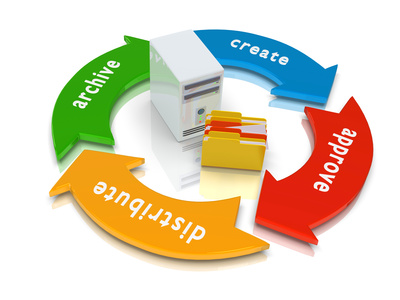From password encryption to limited file permissions, there are different ways to lock down your PDF content. But oftentimes, you may not fully appreciate what they’re capable of. Those features are crucial because though you may not realize it, a PDF file on its own isn’t as secure as you may think.
pdf format
Improving Lean Document Management With Data Extraction

In this day and age, the success of a company relies heavily on efficiency and productivity. As such, systems and services have been developed in order to cut down on waste and reduce the effort in managing workflows and document management. When reassessing the effectiveness of their workflows, companies across all industries use systems like Strength-based Lean Six Sigma.
With the level of data finance and compensation service companies handle, Strength-Based Lean and Six Sigma can work to improve the business process and records management.
What is Strength-Based Lean Six Sigma?
Strength-Based Lean Six Sigma is a system that focuses on assessing and identifying practices used within a company in order to improve it through methodical and active modifications. After best practices (and problems) are identified, steps are then taken to start restructuring the workflow according to the company’s goals and ideals. Companies are then evaluated periodically to ensure the changes made are consistently effective.
This on-going process can show business owners where there are weaknesses, bottlenecks, and wasted effort in their system. As you can imagine, workflows that handle high volumes of documents daily require such evaluation to ensure data processing keeps going smoothly, accurately, and efficiently. If not, business owners can then make adjustments accordingly in regards to both time and activity.
But working to apply that system to clientele data requires more than just a records management system. Companies like CM Global Partners specialize in applying Strength based LEAN and Six Sigma to sales compensation (Lean Sales Compensation). As a consulting company, they assist in strategically planning and creating accurate sales compensation plans for their clients.
The Only Setback In The Workflow
However, in order to create customized Lean compensation plans for companies, they need to deal with the client’s information that comes in the PDF format, a locked down file format that prevents editing of any kind.
Consequently, they would extract the data manually by retyping scanned PDFs into Excel. They had used different software in the past, but needed accuracy. In addition, they needed a way of exporting their clients’ PDF data into Excel that would work with their system, Compensation Master. Their process always required the data to be audited and identical to data in the PDF file.
 “We had an industry leading service,” says David Cocks, CEO of CM Global Partners, “Now we just needed a more efficient way to extract the data.”
“We had an industry leading service,” says David Cocks, CEO of CM Global Partners, “Now we just needed a more efficient way to extract the data.”
Creating the most effective plans possible is CM Global Partners’ priority. So the company decided to invest in Able2Extract to help speed up the data extraction process.
Using Data Extraction To Help With Strength-Based Lean Six Sigma
A case study was done to get a closer look at how and where Able2Extract fit in with their goals and workflow. Some of the benefits that resulted from their move to Able2Extract include:
- $15,000 saved on average
- 80% of time saved on data extraction
- Streamlined their work almost instantly
- Converted large sets of data in a matter of hours with extreme accuracy
- Increased the productivity of everyone on the team
Efficient workflows need efficient systems. However, as CM Global Partners knows, these systems alone aren’t enough if they can’t bridge the gap between their system and their clients’ data.
Read the full CM Global Partners case study to learn how the company successfully integrated Able2Extract with their Lean Six Sigma methodology.
PDF Usability And The Web: Is The Format Still “Unfit For Human Consumption”?

There has always been a well-documented love-hate relationship between users and the PDF format. You either love it when things go right or hate it when it doesn’t co-operate.
Yet for better or worse, the PDF document is in our daily lives. We convert and create PDFs, always emailing and reading them no matter how much we may complain about the format.
But think about what it was like before. Back in 2003, authoritative web usability guru, Jakob Nielsen, criticized the usability of the PDF on the web in his article PDF: Unfit for Human Consumption, in which he catalogs what he calls the format’s “usability crimes.”
If you were an early PDF adopter in the late 90’s or early 2000’s, then you could probably relate very strongly to the article. But would you still agree with it after more than 10 years? Probably not. You can’t deny the format’s improvement since then.
Despite the misgivings we have about the PDF, we can’t do without it. Because of large scale adoption, ISO standardization, and third party tools, the PDF format is a heck of a lot easier to work with. But it’s also due in large part, to the Internet itself and how it’s been shaping our user habits.
The State Of Our Online Behavior
Today we live in a highly technological world that co-exists hand in hand with the Internet. And whether we like it or not, our compulsion to stay connected online greatly influences our need to edit and work with documents on the web, including ones that weren’t meant to be edited.
We connect and communicate online. Blogs, social media, and forums are endlessly engaged in discussion. Social networks are highly public, yet personal. We need to access and do things online, to create an individual work space which we can control.

Photo Credit: Justin Marty via photopin cc
It’s no surprise then that because of this necessity, the digital documents we use daily are following this trend. Our files have become part of the interactive and streamlined user experience.
Developers have been giving digital documents like the PDF a lot of integrated support. Online app services like Google Drive, for instance, allow us to upload PDF documents for viewing, commenting, and sharing, all with a simple URL. Desktop tools are also extending document sharing to real time collaboration over the web.
We can log in from anywhere and check in with our files on-screen. Whether a professional on a tablet or a student enrolled in an online class, we can always connect with PDF contracts and research papers. And on top of this, we can read and download PDF e-books from the web onto our mobile devices.
Using The Internet As A PDF Tool
Let’s not forget that Google has been able to index PDF files since 2001. Since then, the popularity of PDFs online has grown to such an extent that by 2013, 80% of non-html documents posted online were PDF files.
Admittedly, web browsers back in 2003 didn’t support PDF viewing very well. However, browsers like Chrome and Firefox have begun including native PDF viewers. Add to that the ability to create a PDF for fast web viewing and your PDF documents are easier to go through than ever.
What’s interesting to note is that this online PDF viewing and sharing has gradually changed the role of the format itself. Before, the PDF was considered only a final print format. But thanks to online services and advanced PDF creation and editing tools, it can be manipulated at any point in the workflow.

Photo Credit: Saad Faruque via photopin cc
Consider how and when you’ve used online converters and web apps, or social networks and document search engines for a PDF. What did they do to help you with the file? Given the right utilities and extensions, we can interact with PDFs in our browser or annotate, highlight, and merge them instantly.
Truth is, it isn’t as hard to work with PDF files online as it used to be. In fact, presenting PDF content online is now perhaps the most basic thing you can do.
But what do you think? Is the PDF still hard for you to consume online–viewing, handling, or otherwise? It seems that with the way the Internet and the format are developing, there’s no better time to be a PDF user than now.
Should We Add Another Format To The PDF-Killer List?
An interesting tidbit for this week. There’s a new format on the block and it looks like it’s drumming up some buzz as the next PDF-Killer.
The last one to hit the industry, if I remember correctly, was the XML Paper Specification (XPS) format about 4 years ago when Microsoft Office 2007 was being released with XPS creation capabilities. This time around, it’s the CDF format—Computable Document Format, a newly innovated open format that puts “interactive documents” on another level.
Having been developed by the team over at Wolfram.com, the CDF format uses mathematical computation technology to render the live interactive element of its content. The company is known for its computing software program and platform, Mathematica, which, in a nutshell, is used for computing data visualizations needed in fields dealing with complex data, information analysis, and mathematical formulae.
What is the CDF format?
According to the site, the CDF is “as everyday as a document, but as interactive as an app.” Instead of simply viewing static text, images, and tables, with a CDF document you can manipulate them through inputting data, clicking on controls, and moving sliders. If you have a graph with data calculated and projected over time, you can modify those values and see the changes visualized–on the spot.
Looking at the CDF files they have on-site, you can see why it’s being called a PDF-Killer. From a user point of view, the CDF format shares a lot of the same basic similarities and uses as the PDF: it requires a file viewer (CDF Player), can contain different types of content, and is only editable in Mathematica or other CDF content creators (creating an interactive CDF actually requires a bit of coding rather than a one click creation method, though).
The PDF already has interaction capabilities with the ability to play videos, Flash games, and manipulate 3D objects. But so far, as Conrad Wolfram (strategic & international development director of Wolfram) points out, those types of interactivity are pre-generated for you.
The CDF format provides a unique way of creating, consuming, and understanding informational content. As it is with all formats, though, each has its own strengths and uses, some of which are necessary, some not. Simple resumes and articles, for example, are still perfectly fine as a PDF. Live data and textbooks, however, may be better in CDF.
Rather than a question of will the CDF replace the PDF, I think the question facing PDF users is how the CDF format will interact with PDF files over the long run. The format was just launched, so it’s still in the early stages of adoption. So far, as per the FAQ, you can import content from PDFs and the CDF Player plugin is only supported by web browsers (no embedding CDF files in PDF, for instance).
Download the CDF player and take look at a few CDF examples in action for yourself.
How Has Web 2.0 Made An Impact On The PDF Format?
If you were to come up with a good sampling of trends you see online, what would be included in that list? Facebook, YouTube, G-mail, ebay? Perhaps Yahoo!, Google Maps and Wiki sites as well. Let’s not forget the infinite number of blogs, RSS feeds, tagging, podcasting and bookmarking sites that are out there. If you’ve listed these, then you’ve listed a good sample of Web 2.0 elements.
Web 2.0 is a term that you’ve probably seen around on the Internet, and perhaps a term that is a bit obscured. Coined by Tim O’Reilly in 2004, the term encompasses a broad definition. But in a nutshell, it refers to the general trend in which the World Wide Web is going—a more connected and dynamic direction than ever before.
Broadly speaking, Web 2.0 places emphasis on the web as platform. Moreover, the user participation that enriches it, the networks that add to it, the tech innovation that motivates it, and the data that drives it, are all hallmarks of a Web 2.0 application. The result of such a combination? A web environment in which users can do more.
From just that short description alone, you can see that it’s a Web 2.0 world out there. And it’s seeping into the PDF world simply by influencing our digital habits and interests. For example, web designing tools are turning users into developers. If you’re a downloader, you’re a server as well. Desktop publishing software can make the user both publisher and reader at the same time.
These desktop applications, in turn, are then gradually shifted to web applications. Whether or not you’re an avid user of the PDF, you can see that these characteristics play a role in how we look at the file format in a different way, how it’s used, how it’s innovated and how it can be made more efficient online.
Web 2.0—It’s presence, It’s Impact, And It’s Influence On The PDF
Along with this Web 2.0 growth, Adobe has been taking PDF and its authoring tools and combining it with the web tools of Macromedia. This is forming an important relationship between the PDF and online content.
And this is why the PDF is gaining a foothold as Web 2.0 further develops. Adobe’s AIR is a runtime client that can render PDF, HTML and Flash content that can work external to the browser and as a desktop application connected to the Web while still taking advantage of your local storage and hard drive. This is just an example of PDF technology being leveraged for the web.
There is so much PDF content on the web because the PDF is accomplishing what other formats can’t do online. For instance, if you take a look at the main use of PDFs today, three words that might come to mind are: Interactive Document Processing. This is an efficient way of connecting both business workflows and the Web to each other.
The PDF format is becoming the interface between businesses and users. Just because of the sheer growth of the Internet and the wide user-base websites have established, it’s now convenient that tax forms be downloaded in PDF, or that applications be filled out online. Document processing and dynamic security control is what software and online services like LiveCycle Design ES and Adobe Document Server is geared towards–creating and connecting custom tailored backend systems with the client user.
Real time collaboration is now a major feature that enhances PDF workflows. The format is no longer a static virtual page , but a dynamic virtual space. This connectedness is also accompanied by hyperlinking, a thing to which other online documents is not immune. The format actually goes beyond the identity of a closed format and connects to the web and to users online.
However, what makes the PDF more unique is that the Adobe Reader is feature rich. Reader 8.1 can now support RSS feeds in XML format, a more dynamic and heavy duty linking than simple hyperlinking can provide. A Reader can keep you in touch with dynamic content that’s constantly updated.
Another aspect of today’s web is the “openness” of software and technology that is now becoming the norm for Web 2.0. It generates user input and contribution that drives the innovation and integration of different technologies.
Software manufacturing is becoming a communal project. The Adobe Mars project, for instance, still in beta status, is an example of this communal production. In one sense, Web 2.0 has made PDF users participants, third party developers and innovators all in one.
The user perspective on the PDF is changing drastically in that anyone can create one for any purpose, not just for those dealing with top corporation documents. This allows users to spontaneously create and share PDF files as you would normally email media or image files. PDFs are being uploaded and downloaded publicly on webpages in the form of documents and data containers.
In one form or another, the PDF is being developed in stride with Web 2.0 in mind. The PDF has gradually shifted its position and is a far from what it was three versions ago, the last version especially. If Web 2.0 is a vision of what the web could be, then the PDF format is a vision of what Web 2.0 documents should be.